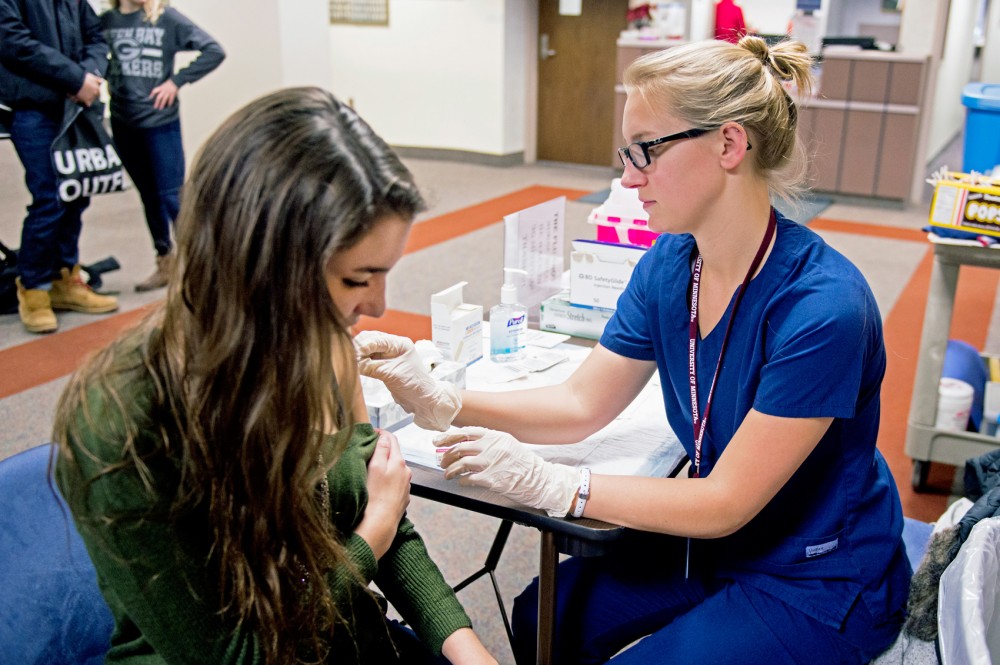The University of Minnesota community is gearing up for the approaching flu season.
Between prevention, outreach and management, there are many ways to tackle the season that leaves so many people sick. The largest initiative Boynton Health will handle during the upcoming months is setting up mass flu clinics. And while it seems like flu season is still a month or two away, some cases of the flu have already been reported in Minnesota.
“Each flu season always seems to be a little bit of a surprise,” said Susan Kline, a professor of medicine at M Health.
The entire flu season is long and can last half the year. As it often peaks in early winter, she said students should prepare for a late December or early January flu season.
During the 2017-2018 flu season, nearly 20,000 people received flu shots from Boynton. With about 10,000 of those being students, one-fifth of the student population received a flu shot from Boynton last year. In the previous season, around 17,500 people received shots from Boynton, including about 9,000 students, according to data provided by Boynton.
“We try to get as [many] vaccines out there as quickly as possible ahead of flu season,” said Dave Golden, the director of public health and communications at Boynton.
Ideally, he said, Boynton wants to make it as barrier-free as possible for people to get vaccinated, which comes as initiatives like keeping lines short and setting up flu clinics in common areas. There has also been a push for providers to offer flu shots to patients who come in for non-flu related reasons.
“We don’t want people to have to wait in line,” he said. “We go where they are and make it [available] at different locations where people can access it.”
A single flu vaccine protects against three or four different strains of the flu and is updated annually with what researchers believe will be the most common viruses that season. Most standard-dose shots that people get this year will be quadrivalent, meaning they can protect against four viruses.
Between 2010-2014, the Center for Disease Control was able to estimate that anywhere from 12,000 to 56,000 people die annually from the flu and related complications, but deaths are hard to track.
Flu vaccine effectiveness varies from season to season, but the CDC says it’s still important to be protected.
“People need to not let the perfect be the enemy of the good,” said Mark Schleiss, a professor in the Department of Pediatrics. “Vaccines work – they prevent disease and most importantly, they prevent death.”
Recent studies show that flu vaccination reduces the risk of the flu by between 40 and 60 percent among the overall population during seasons when most circulating flu viruses are well-matched to the flu vaccine, according to the CDC.
How to survive flu season
1: Get the flu vaccine
Influenza vaccination during the 2016-2017 flu season prevented an estimated 5.3 million influenza illnesses, according to data from the CDC.
The flu vaccination has also been shown to reduce the severity of the flu in people who get vaccinated but still get sick, according to the CDC.
Schleiss said people can’t get the same flu strains that are present in the vaccine.
“It’s biologically impossible,” he added. “It’s unfathomably incorrect and it has no scientific plausibility.”
2: Don’t get others sick
Medical professionals agree that if people are sick, they should avoid contact with others.
“Don’t work when you’re sick, don’t expose people to influenza,” Schleiss said. “Give your colleagues a break and limit your exposure to others.”
Review the excused absence policy for the University, and keep in mind that illness-related absences cannot be penalized.
3: Practice common sense health
The Minnesota Department of Health recommends to wash hands and clean commonly touched surfaces such as door knobs, refrigerator handles, phones and water faucets often.
“It’s a fairly tough little bug,” Golden said. Make sure to wipe down surfaces because it can live on those areas for a long time, he said.
It also might be a good idea to press pause on some party games for a few months, he said.
“Things like beer pong are a great way to pass influenza,” Golden added. “It’s perfect for transmitting any kind of infectious disease like that. It’s literally hands to hands and mouth to mouth.”








